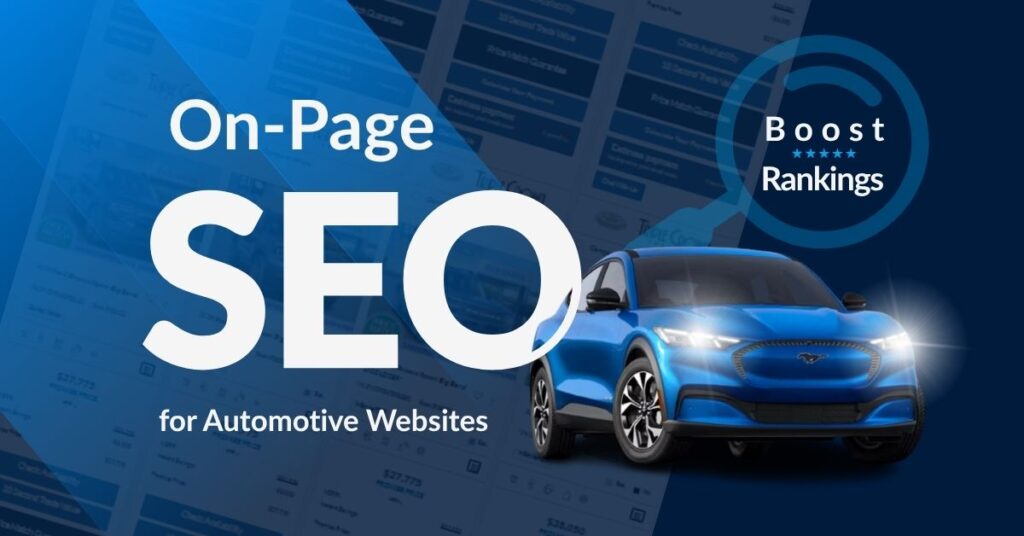Today, people look for cars on their phones and computers, not in showrooms. They search for things like “best Honda dealership near me” or “SUVs under $20k in my area” before they even visit. This means your online presence is key to your success.
We know the digital world is tough for car dealerships. Your inventory changes all the time, and local competition is fierce. Buyers want quick access to car info. That’s where smart search optimization comes in.
This guide will show you how to be on top in local search results. We’ll teach you to link your cars with eager buyers when they’re searching. These tips will help you tackle real challenges, improve user experience, and bring more people to your showroom.
Key Takeaways
- Car buyers start their search online before visiting dealerships, making digital visibility key for sales success
- Local search optimization helps your dealership show up when customers search for vehicles in your area
- Strategic website optimization connects your inventory with buyers at the right moment in their purchase journey
- Constantly changing inventory requires dynamic optimization strategies specific to automotive businesses
- User experience improvements directly impact search rankings and customer engagement
- Actionable optimization techniques can be implemented immediately to improve online visibility
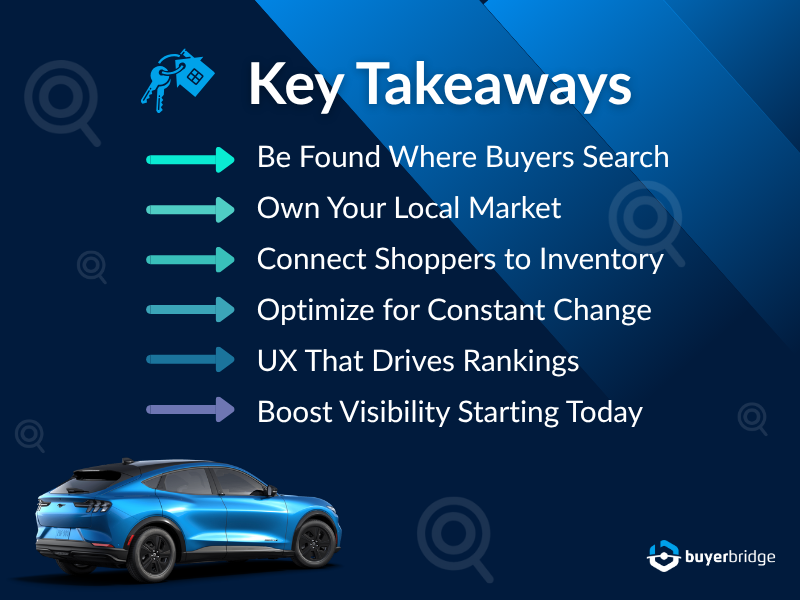
Understanding SEO Fundamentals for Car Dealerships
Car dealership marketing is more than just basic SEO. Your business needs special strategies because of its unique environment. Unlike regular retail sites, car dealerships have to deal with changing inventory, various service areas, and strict rules from manufacturers.
Why Automotive Websites Need Specialized SEO Strategies
Car websites face challenges that regular SEO can’t solve. Your inventory changes every day, making it hard for search engines to keep up. This constant change is a big technical problem.
Car dealerships have many areas to manage online, like sales, service, and financing. Each one needs its own SEO plan. Generic strategies can’t handle this complexity.
Key Ranking Factors for Auto Dealer Websites
Search engines look for certain things when ranking car dealer sites. Being local is key because most buyers look for cars nearby. How close you are to searchers affects your visibility.
Keeping your inventory fresh is also important. Search engines like sites that update their listings often. Fast page load times are vital, too, because of all the images of cars.
Common SEO Challenges in the Automotive Industry
The car industry has big SEO hurdles. With over 18,000 dealerships, getting noticed is tough. It’s hard to stand out.
Many dealers struggle with duplicate content, using the same descriptions from manufacturers. Slow-loading image pages also hurt rankings. And, following OEM rules can limit how much you can optimize your site.
🚀 Tired of rebuilding the same SEO pages every month?
See how SEOFlow automates page creation and optimization →
Automotive Keyword Research and Strategy
Car buyers spend over 14 hours researching online before buying. They look for specific terms, not just “car dealership.” This shows a big chance for dealerships to attract more leads.
14 HOURS
Buyers Spent Online Researching Before Making a Vehicle Purchase
People search for things like “used Honda Civic under 15k in Austin” or “best SUV for families.” This gives dealerships a chance to target their ads better.
Identifying High-Value Car Buying Keywords
High-value keywords show buyers are ready to buy. They include specific details like price, make, and model. We look for keywords that match what buyers want.
- Price ranges and financing terms
- Specific makes and models
- Geographic locations
- Condition preferences (new, used, certified)
- Feature requirements (fuel efficiency, safety ratings)
These keywords have less competition but lead to more sales. They catch buyers who are ready to buy.
Long-Tail Keywords for Vehicle Listings
Long-tail keywords are key for car searches. They are longer and more specific, like “reliable family sedan under 20000” or “fuel efficient compact car for city driving.”
We add these keywords to car descriptions and inventory pages. This helps you rank for more specific searches that others miss.
Competitor Keyword Analysis in the Auto Industry
Looking at competitors is important. We check both direct and indirect competitors. Direct competitors are other dealerships nearby. Indirect competitors are manufacturer sites and other car platforms.
We study their keywords to find gaps for you. This shows which keywords bring them traffic and where you can shine.
💡 Want keyword and performance insights built for automotive?
Explore the SEOFlow dashboard and keyword tracking tools →
Seasonal Keyword Trends for Car Sales
Seasons affect car searches. People look for convertibles in spring and four-wheel-drives in winter.
We help you plan for these trends. This way, your content matches the buying seasons all year.
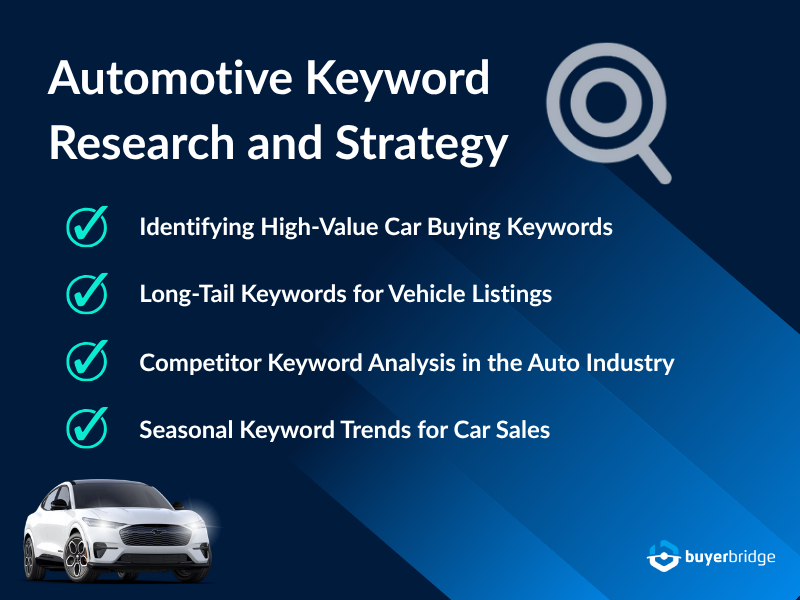
Optimizing Auto Dealer Website Structure
A well-organized automotive website is like a showroom where visitors can easily find what they need. Your website’s structure is key for both a good customer experience and search engine rankings.
Organize your site with core categories that match how customers think. Start with these key sections:
- New vehicles
- Used vehicles
- Service and maintenance
- Financing options
- Parts and accessories
- Trade-in services
This structure helps search engines understand your site. It also guides customers through their buying journey.
Creating SEO-Friendly URL Structures for Vehicle Pages
Your vehicle pages need URLs that are easy for both humans and search engines. Use this format: yoursite.com/used-cars/make/model/year/trim-level.
For example: yoursite.com/used-cars/honda/accord/2023/touring. This format includes important keywords and is easy to remember. Avoid URLs with long strings of numbers or random characters.
Try to keep URLs under 60 characters. Include the vehicle’s make and model for better SEO.
🧩 SEOFlow builds pages with schema-rich, SEO-friendly URLs — automatically.
See how it works →
Internal Linking Strategies for Car Inventory
Smart internal linking connects related vehicles and services. Link similar vehicles on each listing page to keep visitors browsing.
Connect service pages to relevant vehicle categories. For example, link your oil change page to all vehicle maintenance sections. This strategy distributes page authority and helps customers find more services.
Use descriptive anchor text with relevant keywords. Instead of “click here,” use “view similar Honda sedans” or “explore financing options.”
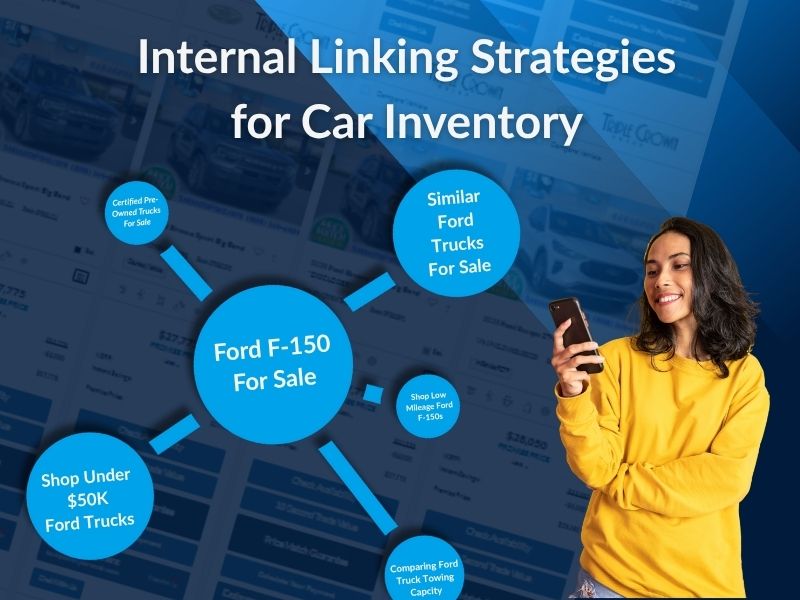
Navigation Best Practices for Automotive Websites
Your main navigation should have no more than seven primary categories. Too many options overwhelm visitors and hurt conversion rates.
Implement search filters that let customers narrow results by price, mileage, year, and features. Make these filters visible and easy to use on mobile devices.
Add breadcrumb navigation to help users understand their location within your site structure. This feature also provides additional SEO benefits by creating more internal links.
Automotive Title Tag Strategy and Implementation
Effective automotive title tag strategy changes how your dealership shows up in search results. Title tags and meta descriptions are the first thing people see. They should highlight your key keywords and offer value to get clicks.
Creating great title tags is about finding the right balance. We use proven methods to make your site stand out in local searches. This strategy boosts your visibility and brings in the right kind of traffic.
Title Tag Formulas for Vehicle Listings
We suggest using specific formulas for your vehicle listings. These include year, make, model, trim, and location. This way, your titles match what people search for online.
| Formula Type | Structure | Character Count | Example |
| New Vehicle | Year + Make + Model + Trim | Dealership + Location | 45-55 | 2024 Honda Accord EX | Smith Honda Dallas |
| Used Vehicle | Year + Make + Model + Mileage | Used Cars + Location | 50-60 | 2022 Toyota Camry 15K Miles | Used Cars Austin |
| Luxury Vehicle | Year + Make + Model + Features | Luxury Cars + City | 45-58 | 2023 BMW X5 AWD Loaded | Luxury Cars Miami |
Brand and Model Optimization Techniques
Optimizing for brand and model goes beyond listing specs. We study search patterns and user intent. This helps us create titles that speak to your audience.
Local SEO Integration in Title Tags
Local SEO is key for car sales, as most happen locally. We show how to add location-based keywords naturally. This helps you rank well in local searches without overdoing it.
Automotive Metadata Techniques for Better Rankings
We think mastering metadata is key for top automotive websites. These hidden elements help boost your search rankings and bring more visitors to your car listings.
Creating great meta tags is vital for success. Your metadata connects search engines to customers, making every word count.
Writing Compelling Meta Descriptions for Car Pages
Meta descriptions are your sales pitch in search results. They give users a quick, engaging summary that makes them click over others.
Good automotive meta descriptions should include:
- Specific vehicle details (year, make, model, trim)
- Unique selling points (low mileage, certified pre-owned, special pricing)
- Clear calls-to-action (“Schedule test drive today”)
- Local relevance when applicable
Keep descriptions between 150-160 characters to avoid cuts. Use phrases like “limited time offer” to create urgency and prompt action.
✍️ Stop writing every meta tag by hand.
SEOFlow formats meta data and schema automatically for every page →
Header Tag Hierarchy for Vehicle Information
Using a header tag hierarchy makes vehicle info easy to scan. It improves user experience and boosts search rankings.
Organize your automotive headers like this:
- H1: Vehicle name and primary keyword
- H2: Major sections (Features, Specifications, Pricing)
- H3: Detailed subsections (Engine specs, Safety features, Financing options)
This structure helps both users and search engines see your content’s value and authority.
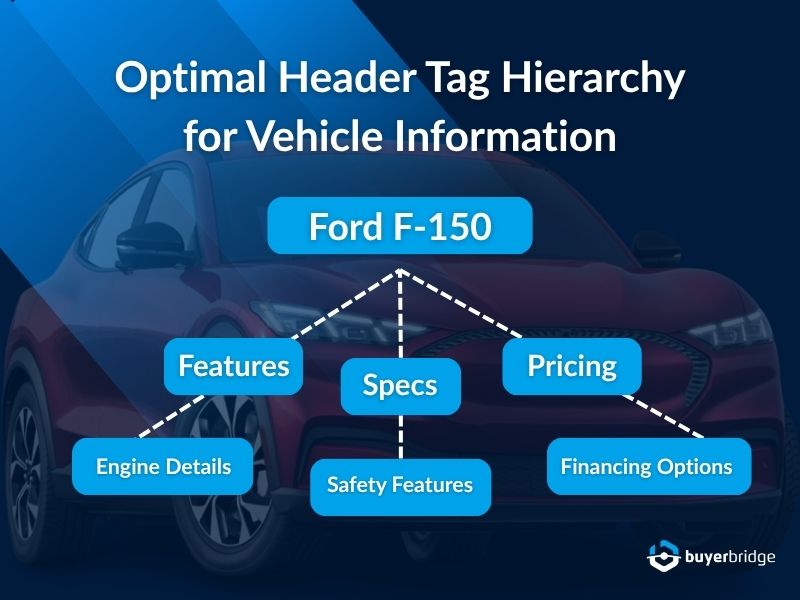
Image Alt Text Optimization for Automotive Photos
Optimizing image alt text is a chance to stand out. It meets accessibility needs and boosts SEO.
Describe vehicle features, angles, and conditions in your alt text. Use relevant keywords naturally. Make sure image quality doesn’t slow down your site.
Vehicle Listing Schema Markup Implementation
Schema markup changes how search engines see your cars. It makes your listings show up better in search results. We help dealerships add structured data to show star ratings, prices, and when cars are available.
This tool makes your listings stand out. It beats basic search results.
Structured data connects your website to search engines. It helps Google understand your cars better. This means more people find your dealership online.
Structured Data for Car Inventory Pages
Vehicle listing schema markup needs specific types. We suggest using Vehicle schema for each car page.
It includes important details like:
- Make, model, year, and trim level
- Pricing and financing options
- Mileage and condition status
- Key features and specifications
- Availability and stock numbers
Each car page needs its own schema markup. This helps search engines show your inventory right in search results.
Review and Rating Schema for Dealerships
Customer reviews boost click-through rates in search results. Review schema markup shows your dealership’s reputation in Google listings. We teach you to use aggregate rating markup for star ratings and review counts.
This data builds trust before visitors see your website. Higher ratings mean more organic traffic and better sales.
Local Business Schema for Auto Dealers
Local business schema tells search engines about your dealership. It includes location, hours, and services. Key details are your address, phone numbers, hours, and service areas.
Good local schema makes you show up in “near me” searches. This brings more people to your dealership.
Testing and Validating Schema Markup
Testing makes sure your schema markup works right. Use Google’s Rich Results Test and Schema Markup Validator tools. They check if your markup creates the right rich snippets and find any mistakes.
On-Page SEO for Automotive Websites Content Optimization
Content optimization turns automotive websites into powerful sales tools. We help dealerships create content that ranks well and converts visitors into leads. It’s all about finding the right balance between search engine needs and customer wants.
Many dealerships struggle because they publish generic content. But, real success comes from content that answers buyer questions and ranks for specific keywords. We focus on creating content that matches what buyers are actually searching for.
Creating Unique Vehicle Descriptions That Convert
Generic descriptions can hurt your website’s performance. We write unique descriptions that highlight the benefits and address buyer concerns. Each description should focus on what makes the vehicle special and why it’s a good choice.
Effective descriptions use emotional triggers and practical information. We include details about reliability, safety, and lifestyle benefits. This approach helps your inventory pages rank better and convert more visitors into leads.
✨ Create SEO-optimized, unique car pages in minutes.
Use SEOFlow’s page builder to generate content fast →
Optimizing Service Pages for Auto Repair Keywords
Service pages are a great opportunity for most dealerships. We create detailed service content targeting specific keywords. These pages attract customers with immediate needs.
Optimizing service pages means explaining procedures and pricing clearly. We also focus on local repair searches and maintenance schedules. These pages often convert better than inventory pages because they meet urgent customer needs.
Blog Content Strategies That Drive Car Sales
Strategic blog content guides customers through their buying journey. We create content that answers real questions and naturally leads readers to inventory and services. This builds trust and authority with buyers.
Successful automotive blogs cover comparison guides, buying tips, and local market insights. We align blog topics with inventory and seasonal trends. Targeting long-tail keywords helps drive car sales.
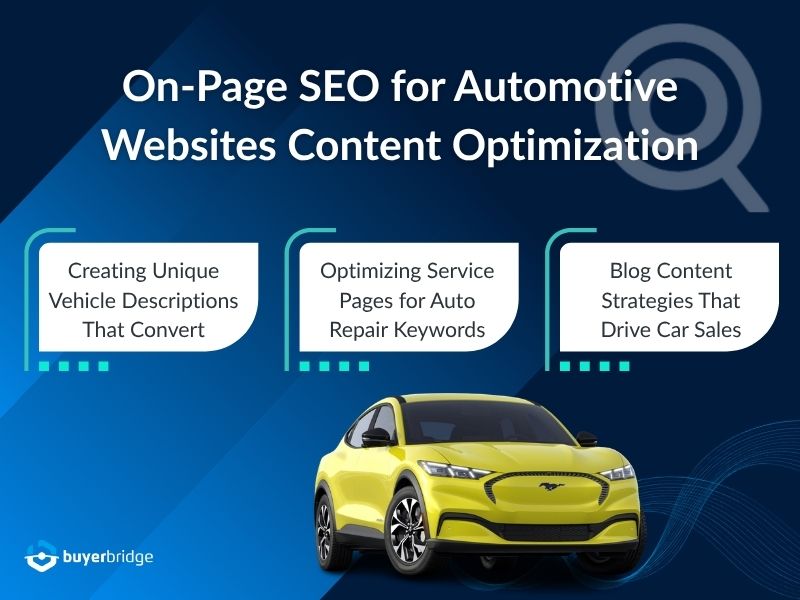
Content Freshness and Regular Updates
Search engines favor websites with fresh content. We keep content current with seasonal updates, market trend coverage, and inventory posts. Regular updates show relevance to search engines and customers.
| Content Type | Primary Purpose | Update Frequency | SEO Impact |
| Vehicle Descriptions | Convert inventory views | Per new arrival | High for long-tail keywords |
| Service Pages | Capture repair needs | Quarterly | Strong local search presence |
| Blog Posts | Build authority and trust | Weekly | Broad keyword coverage |
| Market Updates | Demonstrate expertise | Monthly | Seasonal keyword targeting |
Local SEO for Auto Dealers and Car Lots
Most car buyers look for dealers within 10 to 25 miles. This makes local SEO key for success. 76% of smartphone users visit a business near them within a day. So, your dealership needs to be at the top of local search results to attract customers.
%
Smartphone users who visit a business near them within 1 day.
Being visible locally is critical for your dealership’s success. Buyers want quick access to nearby dealerships. We’ll guide you on how to create a strong local SEO strategy to top local search results.
📍 Launch city-specific “near me” pages without coding.
See how SEOFlow builds backyard SEO pages automatically →
Google My Business Optimization for Dealerships
Your Google My Business profile is your digital storefront. Make sure to fill out every section with accurate info, like hours and contact details.
Upload great photos of your lot and staff often. Share updates on new inventory and deals. Choose specific categories like “Car Dealer” and “Auto Repair Shop.”
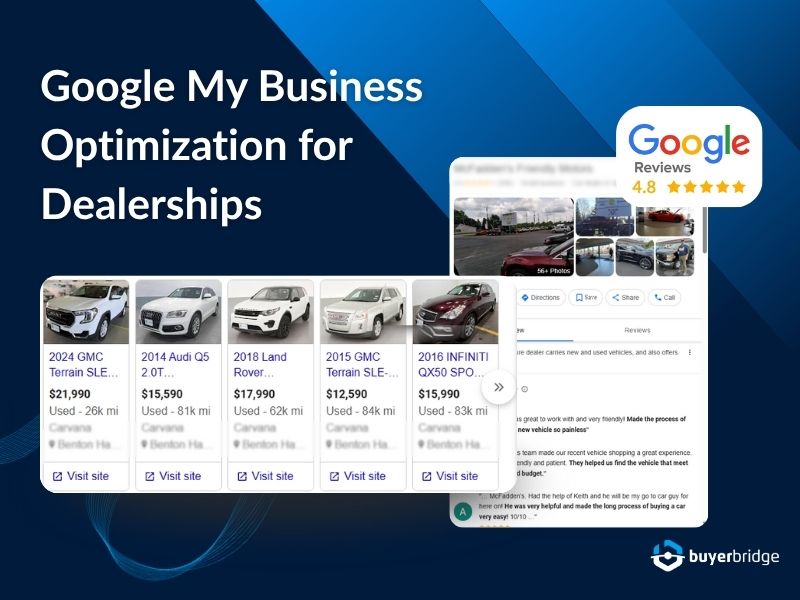
Location-Based Landing Pages
Make pages for each community you serve. Include local landmarks and neighborhood names. Add content that speaks to local residents.
Provide driving directions and local phone numbers. Mention nearby businesses. This helps you rank for searches like “car dealers near [neighborhood name].”
Local Citation Building Strategies
Build consistent listings across automotive and local directories. Start with big sites like Cars.com and AutoTrader. Then, expand to general directories.
Keep your business name, address, and phone number the same everywhere. Inconsistent info hurts your local search rankings.
Managing Online Reviews and Reputation
Online reviews affect your local rankings and customer trust. Ask happy customers for reviews right after they buy or get service.
Always respond to reviews, good or bad. Thank positive feedback and offer solutions for negative reviews. Provide contact info for further discussion.
Mobile Optimization for Car Websites
More than 60% of auto searches happen on mobile devices. Making your dealership’s website mobile-friendly is now essential. Google indexes mobile sites first, affecting your SEO and sales.
60%
Of Auto Searches Happen on Mobile Devices.
Mobile optimization means focusing on how people view cars on small screens. Your “Book a Test Drive” button must be simple to find and tap. Every part of your site should work well on all devices.
Responsive Design for Vehicle Browsing Experience
Responsive design is more than just fitting your site on different screens. We create layouts that show off vehicle photos, specs, and contact info on every device. Your images should load fast without losing quality.
Think about how people swipe through photos on their phones. Make sure your image carousels work smoothly with touch gestures. Specification tables should be easy to read without needing to scroll horizontally.
Page Speed Optimization Techniques
Car websites face speed challenges due to big photos and lots of inventory data. We suggest compressing images and using smart caching. Every second counts for SEO and customer satisfaction.
Optimize your code by removing unused plugins and scripts. Use content delivery networks to speed up image loading across different locations.
Mobile-First Indexing Considerations
Google uses your mobile site’s content and speed to rank all searches. Your mobile site must have all the key info from your desktop site. We make sure your mobile pages have full vehicle descriptions, contact info, and easy navigation.
Touch-Friendly Navigation for Mobile Users
Design buttons and links for easy tapping with fingers, not mouse cursors. We suggest buttons at least 44 pixels and enough space between them. Your main navigation should be easy to reach with your thumb.
Let’s Wrap This Up
We’ve explored how to boost your dealership’s online presence. These strategies work together to help your business grow. They drive real results.
Your SEO journey begins with strong basics. Start with a good website, local SEO, and content that meets car buyers’ needs. These steps lay the foundation for more advanced techniques.
SEO for car dealerships has a big impact. It puts your cars in front of buyers who are searching. It also makes your service center more visible and improves lead quality.
The automotive industry is always changing. New cars come in, and customer habits evolve with technology. Your SEO must keep up with these changes.
Start making these changes step by step. Begin with technical and local SEO. Then, create engaging car descriptions and optimize for mobile. Each step helps build more traffic over time.
Success comes from knowing your customers’ journey and optimizing every touchpoint. Investing in on-page SEO today helps your brand grow in the long run. Stay focused on growth and keep improving your strategy.
Ready to simplify SEO for your dealership clients?
Learn more about SEOFlow, the automotive SEO software built for agencies →

On-Page SEO for Automotive Websites FAQs
Why do automotive websites need specialized SEO strategies compared to other industries?
Automotive websites face unique challenges. Generic SEO tactics can’t address these issues well. They deal with changing inventory and manufacturer rules.
Car buyers use specific search terms. This requires specialized keyword research and content optimization. Automotive SEO must balance technical and local search optimization.
How do I conduct effective automotive keyword research for my dealership?
Focus on long-tail keywords for different buyer stages. Analyze how customers search for specific vehicles in your area. Include location-based modifiers and financing terms.Use tools like Google Keyword Planner and analyze competitors. Don’t forget seasonal trends. For example, convertible searches peak in spring.
What’s the best URL structure for vehicle listing pages?
Create clean, keyword-rich URLs. Include essential vehicle information. For example: /inventory/2024-toyota-camry-xle-chicago.This approach helps with local SEO and creates memorable URLs. It’s easy for search engines and users to understand.
How should I optimize title tags for vehicle listings?
Use a formula that includes year, make, model, trim level, and location. For example: “2024 Honda Accord EX-L | Chicago Honda Dealer | [Dealership Name]”.Avoid keyword stuffing. Each vehicle listing should have a unique title tag that reflects its features and location.
What schema markup should I implement for my automotive website?
Use Vehicle schema for individual listings. It showcases pricing, mileage, and features directly in search results. Also, use Local Business schema for your dealership information.Review schema displays customer ratings. Organization schema is for brand recognition. Product schema is valuable for parts and accessories pages. This structured data helps search engines understand your content.
How do I optimize my Google My Business profile for better local visibility?
Complete every section of your GMB profile with accurate information. Select specific business categories and upload high-quality photos. Regularly post updates about new arrivals and promotions.Encourage satisfied customers to leave reviews. Respond professionally to all feedback. Keep your hours, contact information, and services updated. Use GMB posts to highlight special offers and new inventory.
What are the most important mobile optimization considerations for car dealership websites?
Prioritize responsive design that adapts to all screen sizes. Ensure vehicle photos and specifications display properly on mobile devices. Focus on page speed optimization by compressing images and implementing efficient caching.Create touch-friendly navigation with appropriately sized buttons. Ensure your mobile site contains all the same content and functionality as your desktop version. Consider how customers browse inventory on phones and optimize the experience.
How often should I update my automotive website content for optimal SEO?
Update inventory-related content as vehicles are sold or new arrivals come in. This shows freshness to search engines. Blog content should be published consistently—at least weekly.Cover topics like market trends, maintenance tips, and seasonal buying advice. Service pages should be reviewed quarterly to ensure accuracy and incorporate new keyword opportunities. Meta descriptions and title tags may need updates when targeting new keywords or adjusting for seasonal trends.
What’s the best way to handle duplicate content issues with manufacturer vehicle descriptions?
Create unique descriptions for each vehicle that go beyond manufacturer specifications. Focus on local benefits, financing options, warranty details, and unique selling points specific to your dealership.Supplement manufacturer content with your own insights about the vehicle’s appeal to local buyers. This approach provides value to customers while avoiding duplicate content penalties from search engines.
How do I optimize service pages for auto repair keywords effectively?
Create detailed service pages that target specific repair and maintenance keywords. Provide valuable information that builds trust. Include detailed descriptions of each service, typical pricing ranges, time estimates, and what customers can expect.Use local keywords like “brake repair in [city]” or “oil change near me.” Add customer testimonials, certifications, and before/after photos when appropriate. These pages often convert at higher rates because they capture customers with immediate needs and strong buying intent.

